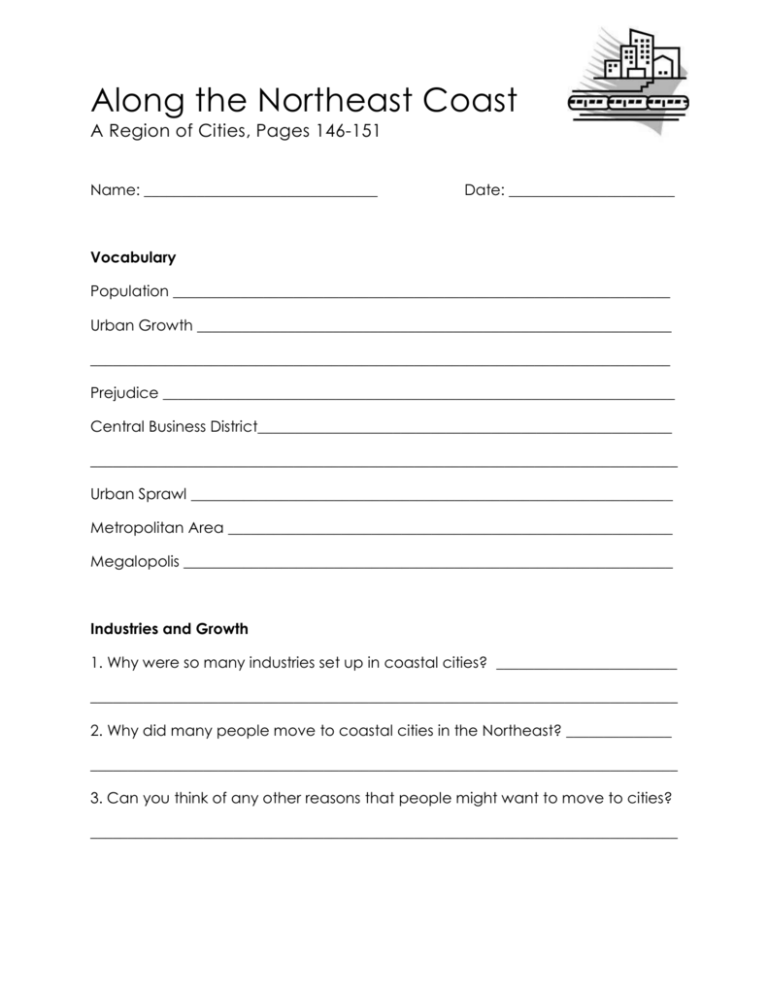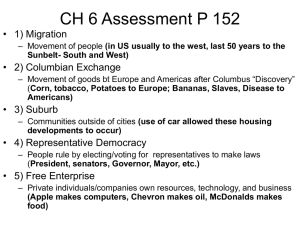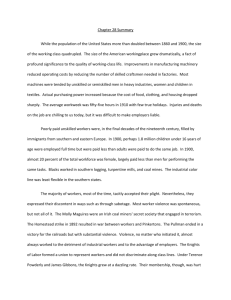A Region of Cities worksheet
advertisement

Along the Northeast Coast A Region of Cities, Pages 146-151 Name: _______________________________ Date: ______________________ Vocabulary Population __________________________________________________________________ Urban Growth _______________________________________________________________ _____________________________________________________________________________ Prejudice ____________________________________________________________________ Central Business District_______________________________________________________ ______________________________________________________________________________ Urban Sprawl ________________________________________________________________ Metropolitan Area ___________________________________________________________ Megalopolis _________________________________________________________________ Industries and Growth 1. Why were so many industries set up in coastal cities? ________________________ ______________________________________________________________________________ 2. Why did many people move to coastal cities in the Northeast? ______________ ______________________________________________________________________________ 3. Can you think of any other reasons that people might want to move to cities? ______________________________________________________________________________ Math Challenge! Extra Credit! ! The chart below lists the population of New York City in 1800, 1900, and 2000. Can you write each number in standard form, short word form, and word form? Year Standard Form Short Word Form 1800 Sixty thousand 1900 2000 Word Form 3 million 8,008,278 What was the growth in population from 1800 to 1900? ________________________ What was the growth in population from 1900 to 2000? ________________________ What do you think the population of NYC was in 2010? (After you write your guess, come to me for the actual census data!) ______________________________ The availability of jobs, which new industries provided, attracted both country dwellers and early immigrants to urban areas. As a result, the Northeast experienced rapid urban growth. Immigrants Crowd into Cities 4. In what way were these immigrants’ lives different from those of the early Pilgrims? _____________________________________________________________________ ______________________________________________________________________________ 5. Why do you think immigrant families had to live in such crowded conditions? ______________________________________________________________________________ 6. What does the quotation (on page 149) imply would happen if a factory worker did not go to work on Sunday? ________________________________________ ______________________________________________________________________________ 7. How did immigrants change the cities in the Northeast? _____________________ ______________________________________________________________________________ The large number of immigrants pouring into cities in the Northeast contributed significantly to the region’s urban growth. Those immigrants had many things in common. They came by ship, they were mostly poor, most moved to crowded tenements, and most worked long hours in factories. *Recommended Reading on this topic: Letters from Rivka, by Karen Hesse Living in Cities 8. What services must cities continually provide? ______________________________ _____________________________________________________________________________ 9. What do cities offer the people who live in or near them? ___________________ _____________________________________________________________________________ 10. Do you ever travel to a large American city to benefit from its exciting attractions? Please tell us about it: ___________________________________________ _____________________________________________________________________________ Today more than three-fourths of all Americans live in or near cities. Cities provide people with a wide variety of services. Cities Change 11. What happened to allow cities to spread out over larger areas? ___________ ______________________________________________________________________________ 12. How are cities today different from cities of the past? ______________________ ______________________________________________________________________________ Prior to new and better means of transportation, the central business district was where almost all activities in a city took place. Today, as a result of urban sprawl, many of these activities take place in the outer parts of the city or in nearby suburbs. Cities Connect 13. Why do you think many of the cities that form the megalopolis are near the coast? ______________________________________________________________________ 14. What do you think will happen as each metropolitan area spreads farther out from the city? ____________________________________________________________ ______________________________________________________________________________ 15. What is a megalopolis? ___________________________________________________ ______________________________________________________________________________ 16. Look at the map on page 151. What large city in Maryland is part of the megalopolis shown on the map? _____________________________________________ Metropolitan areas sometimes continue to grow until they meet with the boundaries of other metropolitan areas. The urban area created by this growth is called a megalopolis. Section Review 17. How has urban sprawl changed cities? ____________________________________ ______________________________________________________________________________ 18. How are cities in the Northeast like cities in other parts of the United States? _ ______________________________________________________________________________ 19. How might urban sprawl affect the wildlife in an area? _____________________ ______________________________________________________________________________











